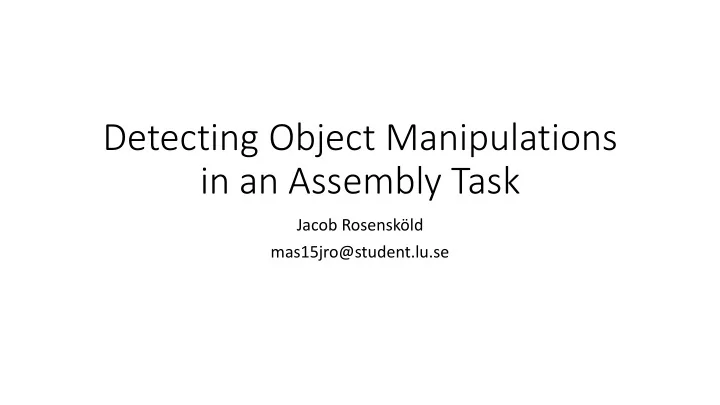

Detecting Object Manipulations in an Assembly Task Jacob Rosensköld mas15jro@student.lu.se
Agenda • Introduction • Methodology • YOLO – Object detection • OpenPose – Pose estimation • Hand activity recognition • Determine which object is being manipulated • Discussion • Future work
Introduction • Detecting object manipulations • Extract information from an assembly video
Methodology Video frame 1. Object detection 2. Pose estimation 4. Using depth camera to determine which object is being 3. Hand activity detection manipulated Sequence/sliding window of hand key points from 32 latest frames
1. YOLO – Object detection • ”You only look once”
1. YOLO - training • About 1000 annotated images. • Image augmentation, increased to about 6000 images. • Mean average precision of 99%.
2. OpenPose – Pose estimation • Estimate body, foot, face and hand key points. • 21 key points per hand.
3. Hand activity recognition • Classify sequences of the 32 frames. • Each frame containing hand key points from OpenPose. • Only used the 5 fingertips. • Two classes: grip and drop
3. Hand activity recognition - architecture LSTM LSTM Dense Input dropout: 0.3 Dropout 0.5 Units: 10 softmax Units: 10
3. Hand activity recognition - training • About 1300 sequences, 70% training, 15% validation, 15% testing • 2000 epochs, batch size of 256
3. Hand activity recognition - results Class Precision Recall F1-score Grip 0.89 0.95 0.92 Drop 0.94 0.87 0.91 Average 0.92 0.91 0.91
Demo 1
4. Determine which object is being manipulated • Depth camera. • Look for sufficient close objects. • Could add more, e.g. looking if object moves in same direction as hand.
Demo 2
Discussion • Does not work that good when tested on video containing a lot of activities and movements. • Detects activities with high confidence even though the person is just moving his hands around. • Grip and drop are very subtle activities.
Discussion • Incorrect classifications. • Grip and drop are similar. • Many of the frames in the sequences for both grip and drop are just the hands moving.
Discussion • The system is made of a number of chained sub systems. • Every sub system adds some uncertainty to the final result.
Discussion • It’s possible to detect subtle movements in 2D, even though improvements are required.
Future work • Train the neural network not using fixed-sized frame sequences. • Stateful LSTM. • Include depth of the hand key points in the data. • Would make it easier to detect subtle movements.
Future work • Add more classes. • E.g. a screwing motion. • Would give a hint of how much the similarity between grip and drop affects the results.
Thank you! Questions?
Recommend
More recommend